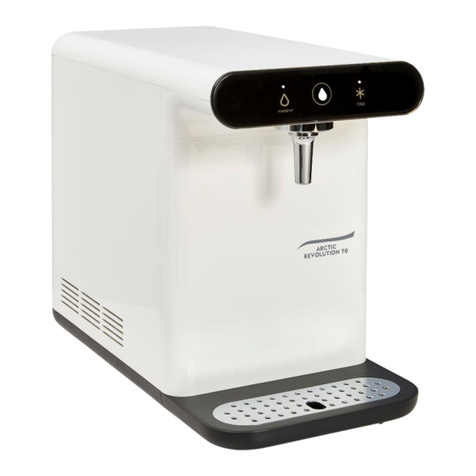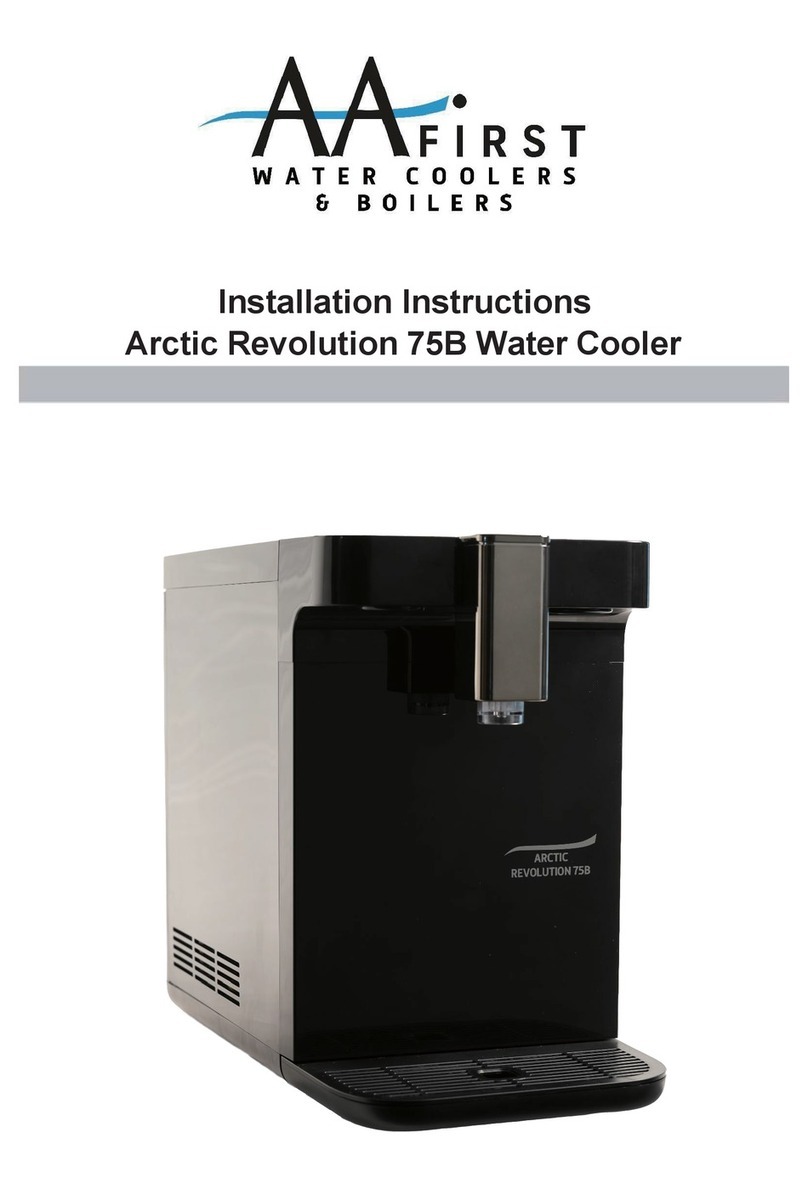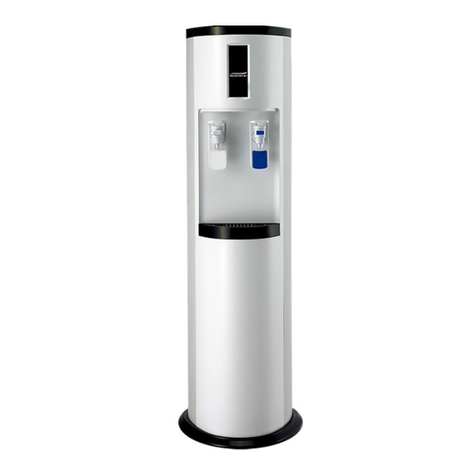AAFIRST Jazz 1000 User manual

Installation Instruction for the Jazz
1000/1100 the 3300 the ArcticChill88/98 the
ArcticStar55 and the AquaPoint60 Water
Coolers
Caution
•When installing a POU Cooler use only new hoses (supplied) and new compression fittings
when connecting to the mains.
•J Guest push fit connections should be regularly checked for leakage. Over time they will
become brittle and need to be replaced.
•If the electrical cord is damaged, it must be replaced by a competent and qualified
individual.
•Children, and persons with reduced physical or mental capability must be instructed and
supervised on the use of the equipment.
•Any maintenance, servicing and moving of the equipment must only be undertaken by a
qualified and trained individual.
•It is strongly recommended that the mains water supply to the POU Cooler is turned off
over week ends and long periods of office closures.
•Please note: Product warranty is ONLY valid if the product installation has been carried out
according to our Installation Instructions and conditions stated on our Terms and
Conditions.
Safe Usage
•Always turn electricity off before working on the equipment
•(POU)Always turn water off at nearest stop cook before working on the equipment
•(Bottled Water) Remove the bottle
•When not in use for an extended period: Turn mains water off or remove bottle. Turn
power off. Sanitise before re-commissioning.
•Install cooler on a flat surface to avoid vibration and noise
•Leave 15cm gap all around to provide good ventilation
•Install away from heat source which could affect the unit's cooling capacity
•Avoid freezing conditions which could rupture the pipes
•Never tilt unit over 45 degrees when carrying to storing
•Wait for an hour after transport before installing to allow coolant to settle
•Fill water reservoir with water before unit is powered up to avoid damage to the
refrigeration and heating element
Commissioning
•For POU Coolers follow the Plumbing & Filter Installation Instructions
•For conversion from Bottled to POU follow the Conversion Instructions
•Sanitise the cooler before first use and follow Sanitising Instructions
•For “Open Tank” Coolers make sure that the water detaching board (Baffle) inside the cold-
water tank is inserted tightly. If not fixed properly, it may affect your cold-water volume
•For POU Coolers ensure that the float, connected to the water tank lid, moves freely
•For Direct Chill Coolers follow Direct Chill Cooler instructions
•Before switching the power on make sure that both the cold and hot water tanks are filled
with water

Converting a Bottled Cooler to POU
(Does not apply to Direct Chill Coolers)
•It takes literally five minutes, using our Conversion Kit
•Remove Bottled Cooler top by unscrewing screws in back
•Place water tank lid from kit on open water tank making sure that the float moves freely
and the 1/4" blue pipe is firmly connected and is guided to the filter bracket Replace
cooler top with POU Lid and fasten with two screws at the back
Sanitising with Buffered Hydrogen Peroxide solution
•Switch power off
•Turn mains water off
•Remove top cover of the cooler to gain access to the water reservoir
•Pour diluted sanitising fluid into the water in the reservoir, wipe all internal surfaces, to
dislodge any Biofilm
•Drain some sanitising fluid through taps
•Sanitise in strict accordance with WHA guidelines using only tested and therefore
endorsed sanitising products
Sanitising a Direct Chill Cooler
•Switch power off
•Turns mains water off
•Remove the Carbon Block Filter and replace with an empty Filter Housing
•Pour the sanitising fluid into the empty Filter Housing
•Turn mains water back on
•Open the taps to flush the sanitising liquid into the tank and pipes
•Leave standing for 10 minutes and then flush through with water to remove all traces of
Sanitising Solution
Warning
•These appliances are provided with refrigerant gas, ISOBUTANE(R-600a).
•The appliance must be transported and moved, taking maximum care to ensure that it is
not excessively struck or shaken. Failure to observe the above rule, could put the appliance
out of service.
•Keep ventilation openings, in the appliance enclosure or in the built-in structure, clear of
obstruction.
•Do not damage the refrigerant circuit. if damage to the refrigerating circuit, with possible
outflow of refrigerating gas, could create risks of explosion caused by external sparks or
flames.
•Do not, on any account, run your appliance if it appears to be damaged.
•In case of damage, contact the Service Centre, ventilate the room where the appliance is
located, and avoid flames or jobs on the appliance.
De-scaling a Hot & Chilled Cooler
(De-scaling automatically sanitises the Boiler)
•Scale is a major problem for Hot Water Tanks in Hard Water areas. A build-up of scale
inside the tank can seriously affect the safety and the performance of the equipment. The
parameters affecting the formation of scale are
•The hardness of the Water
•The temperature of the Hot Water
•The Hot Water consumption
•It is imperative that the Cooler is being de-scaled regularly. It is recommended that de-
scaling is done outside the customers premises
To de-scale
•Turn Power off.
•Drain waterin reservoir through taps, then drain boiler from drain at the back of the cooler
•Remove baffle from cold tank.
•Pour de-scaler into cold tank and allow to gradually feed into the boiler
•Active foaming occurs as a sign that there is scale in the boiler.
•When the foaming stops, all scale should have been removed. This could take 10 to 15
minutes or more.
•Drain descaler out of the boiler
•Fill boiler and cold tank with water (without heating) and drain water out again
•Repeat until all traces of descaler have been removed
•Refill Cooler with water and turn power back on
Connecting a POU Cooler to the mains
•All mains’ connections should be made using a professional Installation Rail (WHA
approved) which includes Copper Compression Fittings, an on/Off Tap, A Pressure
Reducing Valve, a Non-Return Valve and a Waterblock
•Professional Installation Rails are available from a number of suppliers, including AA First.
The AA Installation Rail is available without a Filter (PRAILKIT) for customers wanting to
use their own Filters, or with a Filter (PFRAILKIT).
•Isolate the mains water supply before connecting the Copper Compression Fittings to the
mains
•Connect the Installation Rail to the Copper Compression Fitting
•Connect the Installation Rail to the POU Cooler - which has its power turned off.
•Turn the mains on and check all Push Fit connections and fittings for leaks
•Turn the POU Cooler power on
•Prior to commissioning the Cooler check all mains and electrical connections prior to
commissioning the Equipment

Information
This appliance is intended to be used in household and similar applications such as:
•staff kitchen areas in shops, offices, and other working environments.
•farmhouses and by clients in hotels, motels, and other residential type environments.
•bed and breakfast type environments.
•catering and similar non-retail applications.
AA Water Cooler Service, Maintenance a Recycling
HYGIENE
•Water is our most important FOOD and Water Coolers must be maintained in a
hygienic condition. The Water Cooler Associations demands that all makes and types
of Water Coolers must be regularly sanitised, using approved sanitising
solutions/techniques
•Bottled Coolers must be Sanitised every 3 months
•POU Coolers must be sanitised and the filter exchanged every 6 months
•All Coolers should be sanitised prior to commissioning
•Sanitising should be in accordance with WHA guidelines
ELECTRICAL SAFETY
•All electrical connections/wires should be checked at installation
•(It is possible that some connections have come loose during transport)
•Check the flex cable for any visible damage and ensure that the Cooler is not installed
on top of the cable
•Coolers should be PAT tested by the Distributor if the equipment has been removed
by him from a site and before re-installing it at another site. The User should PAT test
the equipment annually.
•It is recommended that points above form part of the regular routine maintenance
WEEE RECYCLING & LABELLING
All Water Coolers should be recycled at the end of their life according to WEEE Regulation. All
Water Coolers should be marked with: CE marking for electrical safety, RoHS (Restriction of
Hazardous Substances) as proof that the materials used comply with rigorous RoHS legislation
and the Wheeled Bin Symbol to confirm that the Cooler must be recycled under WEEE.
For recycling, contact local waste disposal service or contact the seller. The appliance must be
transported without damage to the cooling circuit.
Troubleshooting
No or low cold or chilled
water
Check if power and water are turned on
Has too much chilled water been consumed and the cooler has not had time
to recover?
The POU filter is blocked and needs replacing
Is the Baffle inserted tightly?
Is the unit too close to a strong light or heat source or too confined in space?
Noise and vibration –The cooler is stood on an uneven surface?
No or low hot water
Check if power and water are turned on
Is hot water switched on
Does the boiler need de-scaling?
Has too much hot water been consumed and the boiler has not had time to
recover?
Check thermal cut out
Is the water valve open
The POU filter is blocked and needs replacing
Noise and vibration - The cooler stands on an uneven surface
Leaking
Check water connections from the mains
Check for internal leaks for poor connection
Check for damage to float switch, which would not turn the water off
Is the Drip Tray overflowing?
ECO Mode not working
Check if ECO switch is turned on
Check if the ECO sensor is blocked

ArcticStar 55 HOT a Cold
Installation instructions
The ArcticStar 55 Hot Water & Hot Water Booster.
The "standard" hot water temperature range is between 82C and 92C. It can be BOOSTED to
95C/96C to provide 1.51tr of piping hot water for instant draw off- The hot water boosting
feature will be operated by pressing and holding the BOOST icon on the top of the upper front
panel Keep the finger on the BOOST icon for 2seconds until you hear a second "beep" to indicate
that BOOSTING is happening. During BOOSTING the light will flash Red. Once the BOOST mode
has completed the light will turn to a solid Red. Boosting time can vary depending on the current
temperature of the water in the hot tank. From 92C this will take approximately 60 seconds to
boost the temperature to 96C.
Attention
BOOSTING has to be done every time you want a higher hot water temperature above 90C to
be boosted to 95C/96C. Be aware that in a hard water area, the higher hot temperature will
result in an increase in Scale in the hot water tank. This will affect the safety and performance
of the equipment. It is therefore imperative that the Cooler is being de-scaled regularly.
The ArcticStar 55 Cold light
A GREEN SOLID LIGHT on the upper front panel indicates that power to the Arctic Star 55 is on.
You can draw chilled water.
The ArcticStar 55 ECO Light Sensor
This ECO feature automatically turns the Boiler off when the office lights are off. It saves about
25% in electricity.
In case the ArcticStar 55 is located in a dark area, it may be necessary to disable the ECO
function by switching it OFF on the back of the Cooler.
Installation
•When installing the unit for the first time the heating switch (HOT S/W) on the back
of the cooler should be in the off position. Please ensure water can be drained from
the hot tank, as a sign that there is water in the tank, before turning the hot switch
on.
•When the heating switch is turned on there will be a 3-minute delay before the
element is switched on. This is a further protection to ensure the element is not
damaged in case there is no water in the hot tank.
Quick Hot Water reference guide
GREEN LIGHT: Power ON
PULSING ORANGE LIGHT : Indicates heating to standard 92C.
SOLID ORANGE LIGHT : Standard temperature range of 92C/82C
PULSING RED LIGHT : Boosting to 95C/96C
SOLID RED LIGHT : 1.51tr of Boosted Hot Water of 96C/90C
HOT WATER BOOSTER : Keep finger on Booster Icon until you hear second beep. Orange or Red
Light will change to Pulsing Red. Once pulsing stops, Lights will show Red.
You can now draw 1.51tr of 95C to 90C water (instant draw off).
Boost Icon
HOT & ECO Switch
Heating indicator light
Power on/off light
Eco Light Sensor
Touch 2 sec!

JAZZ 1000/1100
PRODUCT NAME
Hot & Cold and Ambient & Cold-Water Dispenser
MODEL NAME
Jazz 1000
Jazz 1100
EXTERNAL DIMENSIONS
Floor Standing
Table Top
340(W) X 335(D) X 1020(H)
340(W) X 335(D) X 1020(H)
WEIGHT
Abt. 20kg
Abt. 17kg
GENERAL SPECIFICATIONS
POWER SUPPLY
220-240V~ / 50Hz
POWER CABLE
UK 3 PIN PLUG
CONDENSER TYPE
Wire Type
REFRIGERANT
R-600a
MOTOR POWER CONSUMPTION
0.85A
COLD WATER TANK
S/S 2 LITRES
COLD WATER CAPACITY
200ml 10 cups (6-10C)
TEMPERATURE CONTROL
Thermostat Cold
COOLING TYPE
Forced Cooling Type
HEATER POWER CONSUMPTION
Hot & Cold-Water Dispenser
430W
HOT WATER TANK
S/S 2 LITRES
S/S 1.6 LITRES
HOT WATER CAPACITY
200ML 10 CUPS (80-90C)
HEATER
Band Heater
TEMPERATURE CONTROL
Bi-metal (Auto Return)
OVERHEAT PROTECTION DEVICE
Bi-metal (Manual Return)
CONSTRUCTION
FRONT PANEL
ABS
SIDE PANEL
EGI Colour Panel
FAUCET
PP, ABS, SILICONE
RATED INLET PRESSURE
127-294kPA
3300/ARCTICSTAR55
PRODUCT NAME
Hot & Cold and Ambient & Cold-Water Dispenser
POU MODELS
MODEL NAME
WCPC(H)3300/55
WCPTC(H)3300/55
DESCRIPTION
Floor Standing
Table Top
DIMENSIONS
1140(H) X 340(W) X 340(D)
460(H) X 340(W) X 340(D)
WEIGHT
Abt 26kg
Abt 20kg
INTERGRATED CUP HOLDER
Yes 75 cups
No
EASY ACCESS LOWER FRONT
PANEL
YES, SPRING LOADED
n/a
FILTERS MOUNTED
Internally
Externally
BOTTLED MODELS
MODEL NAME
WCBC(H)3300/55
WCBTC(H)3300/55
DESCRIPTION
FLOOR STANDING
TABLE TOP
DIMENSIONS (MM)
1165(H) X 340(W) X 340 (D)
488(H) X 340(W) X 340 (D)
WEIGHT
ABT. 26KG
ABT 20KG
INTERGRATED CUP HOLDER
YES, 75 CUPS
NO
EASY ACCESS LOWER FRONT
PANEL
YES, SPRING LOADED
N/A
GENERAL SPECIFICATIONS
POWER SUPPLY
220-240V~ / 50Hz
POWER CABLE
UK 3 PIN PLUG
COMPRESSOR
1/10 HP SEALED TYPE
CONDENSER
WRIE TYPE
REFRIDGERANT
R-600a
COLD WATER TANK
S/S 3 LITRE
TEMPERATURE CONTROL
AJUSTABLE THERMOSTAT 4-12C
CHILLING CAPACITY
INFLUENT 22C-18C (5 LITRES PER HOUR BELOW10C)
HOT WATER TANK
S/S 2 LITRE
S/S 1.5 LITRE
HEATING ELEMENT
EXTERNAL BASE HEATER, SHEATH HEATER (ARCTICSTAR55 ONLY)
HOT TEMPERATURE
FROM 92C TO 87C (EXCEPT ARCTICSTAR55)
FROM 92C TO 82C (ARCTICSTAR55
ONLY)
BOOSTER BUTTON
UP TO 95C HOT WATER WITHIN 1 MINUTE (ARCTICSTAR55 ONLY)
ECO MODE
TURNS OFF HOT TANK AUTOMATICALLY IN DARKNESS (ARCTICSTAR55 ONLY)
CONSTRUCTION
SIDE PANELS
EGI
FRONT PANELS
ABS
TOP PANELS
ABS
TAPS
PP,ABS ASSEMBLY
DISPLAY LIGHT
LED TYPE WITH ON OFF SWITCH AT BACK OF COOLER
DISPLAY PANEL
ADD YOUR OWN BACK LIT LOGO BY ADHERINGYOUR OWN TRANSPARANT SELF
ADHESIVE LOGO
RATED INLET PRESSURE
127-294kPa

ARCTICCHILL 88
PRODUCT NAME
Direct Chill Cold-Water Dispenser
MODEL NAME
WCPC88
WCPTC 88
EXTERNAL DIMENSIONS
Floor Standing
Table Top
340(W) X 340(D) X
1180(H)
340(W) X 340(D) X 460(H)
WEIGHT
Abt. 23kg
Abt. 16kg
INTERGRATED CUP HOLDER
YES, 75 CUPS
NO
FLOOD GUARD
YES
HYGIENE GUARD
YES
GENERAL SPECIFICATIONS
POWER SUPPLY
220-240V~ / 50Hz
POWER CABLE
UK 3 PIN PLUG
COMPRESSOR
NS36LAEG
CONDENSER FLOOR STANDING
WIRE TYPE
CONDERNSER TALBE TOP
WIRE TYPE FAN ASSISTED
REFRIDGERANT
R-600a
DIRECT CHILL/PRESSURE TANK
S/S X 1 LITRE
TEMPERATURE CONTROL
5-7C THERMOSTAT SETTING
CHILLING CAPACITY
INFLUENT TEMP 16C
INSTANT DRAW OFF: 120 CUPS
HOURLY CAPACITY: 40 LITRES
SIDE PANELS
EGI
FRONT & TOP PANLES
ABS
DISPLAY LIGHT
LED
RATED IKNLET PRESSURE
127-294kPa
ARCTICCHILL 98
PRODUCT NAME
Direct Chill Ambient & Cold-Water Dispenser
MODEL NAME
WCPC98
EXTERNAL DIMENSIONS
Floor Standing
340(W) X 340(D) X 1180(H)
WEIGHT
Abt. 23kg
INTERGRATED CUP HOLDER
YES, 75 CUPS
FLOOD GUARD
YES
HYGIENE GUARD
YES
EASY ACCESS FRONT PANEL
YES
GENERAL SPECIFICATIONS
POWER SUPPLY
220-240V~ / 50Hz
POWER CABLE
UK 3 PIN PLUG
COMPRESSOR
WX35LHS5W-K
CONDENSER FLOOR STANDING
WIRE TYPE
CONDERNSER TALBE TOP
WIRE TYPE FAN ASSISTED
REFRIDGERANT
R-600a
DIRECT CHILL/PRESSURE TANK
S/S X 1 LITRE
TEMPERATURE CONTROL
THERMISTOR
CHILLING CAPACITY
INFLUENT TEMP 16C
INSTANT DRAW OFF: 120 CUPS
HOURLY CAPACITY: 40 LITRES
PROTECTION DEVICE
SAFETY VALVE 2.8K
SIDE PANELS
EGI
FRONT & TOP PANLES
ABS
DISPLAY LIGHT
LED
RATED IKNLET PRESSURE
127-294kPa

Distributed by:
Cedar House
Grange Farm
Long Lane
Newbury
RG14 2TF
PH: 44 (0) 1635 202489
E-mail: [email protected]
http://www.aafirst.co.uk
AQUAPOINT 60
PRODUCT NAME
Cold/Ambient Bottled & POU Water Cooler
in white or black (B)
MODEL NAME
WCBC60, WCPC60, WCBC60B, WCPC60B,
EXTERNAL DIMENSIONS
1032 (H) x 353(W) x 326(H)
WEIGHT
Abt. 15Kg
COMPRESSOR
1/13 ~ 1/17HP Sealed Type
CONDENSER TYPE
Wire Type
MOTOR POWER
CONSUMPTION
90W
REFRIGERANT
R600a
COLD WATER TANK
S/S 1.9 litre
COLD WATER CAPACITY
20 Cups below 12℃
TEMPERATURE CONTROL
Thermostat (in Cold)
COOLING TYPE
Forced Cooling Type
REGULATED POWER
220-240V~ / 50Hz
POWER CORD LENGTH
1.8M
FRONT PANEL
ABS
SIDE PANEL
EGI
FAUCET
PP Assembly
Other manuals for Jazz 1000
1
This manual suits for next models
6
Table of contents
Other AAFIRST Water Dispenser manuals
Popular Water Dispenser manuals by other brands

IBC Water
IBC Water AST0715MP-960 Installation & operating instructions

Lancaster Water Treatment
Lancaster Water Treatment X FACTOR LX15 Series Installation, operating and service manual

Elkay
Elkay EMABF8 Series Installation & use manual

Oasis
Oasis Osmosis Home installation manual

Monarch Water
Monarch Water ULTIMATE MINI AQUA HE install guide

Haier
Haier HLM-109B instruction manual
















